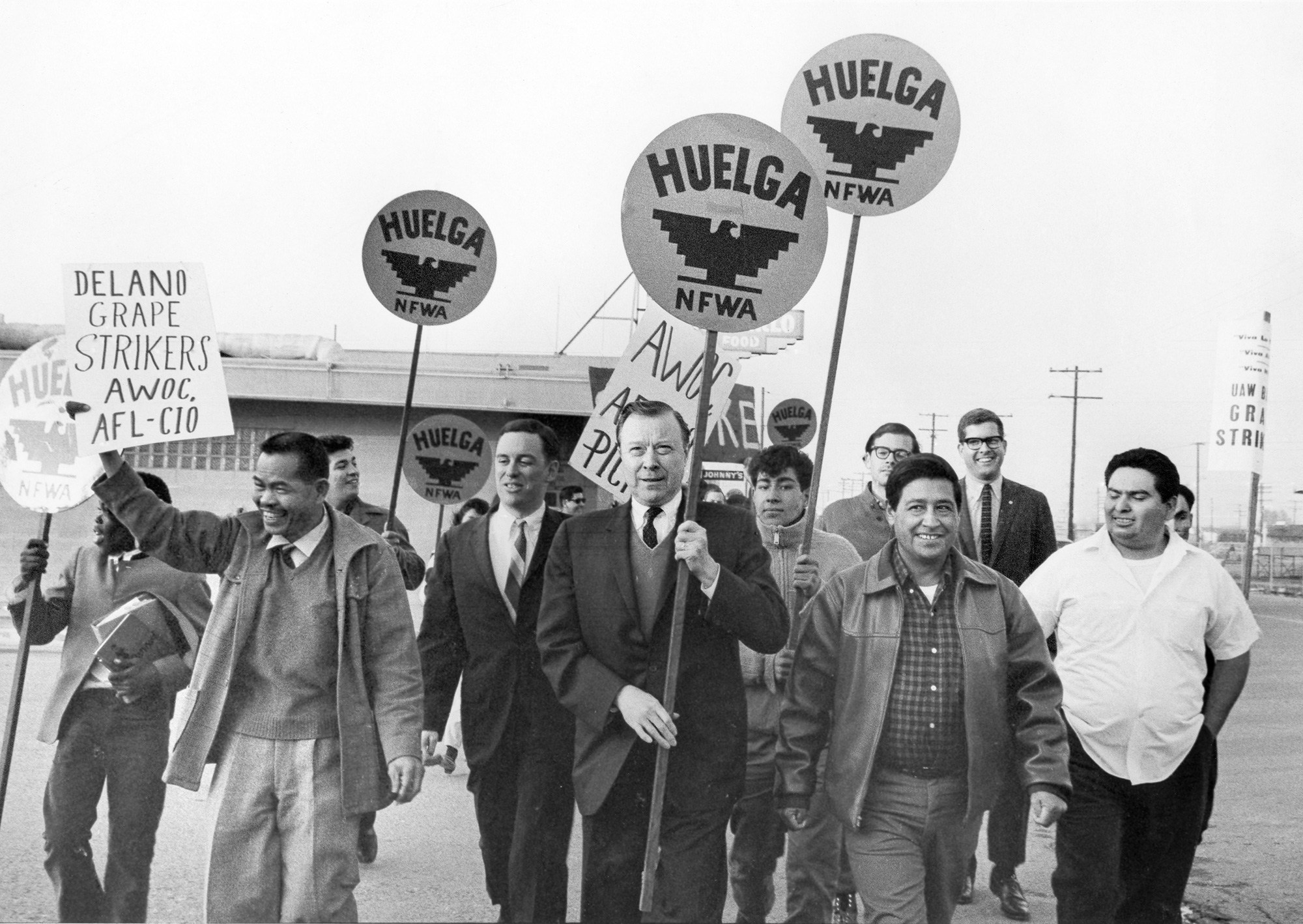TOUR HISTORICAL SITES AT THE ‘FORTY ACRES’
Roy L. Reuther Administration Building & Reuther Hall
The Reuther Hall hosted union meetings at the end of the 1960s grape strike, after the United Farm Workers relocated its original offices from the corner of 1st Ave. and Albany St. in west Delano. UFW headquarters were here from 1968 to 1971, when they moved to the La Paz property at Keene. The building was named for Roy Reuther, brother of United Auto Workers President Walter Reuther. Both were key movement supporters.
In this hall Delano table grape growers signed their first UFW contracts on July 29, 1970, witnessed by hundreds of grape strikers and boycotters. John Giumarra Sr. held up his hands in mock surrender for news cameras as Cesar Chavez and Larry Itliong watched. The hall and the area just east of it served as sites for major union meetings, rallies and observances, including Cesar Chavez’s 1993 funeral services.
See the historical photographic exhibit on the 1965-1970 grape strike and boycott and recognizing Latino and Filipino strikers, extensive button collections from the ‘60s and an exhibit on how the UFW and farm workers continue the legacy today.
Tomasa Zapata Service Station (facing Garces Hwy.)
A co-op gas station providing fuel and auto repairs for farm workers was one of the movement’s earliest services in the mid-‘60s. The first permanent structure built on the “Forty Acres,“ its adobe walls and tile roof in Mission-style architecture set the theme for other buildings on the property. Pumps in front dispensed “Huelga Co-op Gas,” and the west room had bays to repair vehicles.
It was completed in early 1968, it in time for Cesar Chavez to spend most of his 25-day fast for nonviolence inside a tiny room at the gas station that February and March. Here, Senator Robert F. Kennedy greeted Cesar before attending a mass ending the fast at Delano’s Memorial Park on March 10, 1968.
Two visible blemishes reflect the tensions of the times. Bullet holes on the building’s south walls were fired from a passing vehicle in the late ‘60s. A bomb exploded near the southwest corner during the 1973 grape strike, damaging the adobe wall.
See another historical photographic exhibit on the ’65 grape strike and the small room where Cesar Chavez fasted in 1968, preserved as it looked then.
Paulo Agbayani Retirement Village (northeast corner of the Forty Acres)
When the Delano Grape Strike was won in 1970, most Filipino strikers who began the walkouts were too old to return to work. They were imported from the Philippines as young men in the 1920s and ‘30s. Forbidden to marry by racist anti-miscegenation laws, most had no families to care for them and no decent places to live.
So the farm worker movement built the Paulo Agbayani Retirement Village in 1974, to provide the Manongs, most of them veterans of the ’65 strike, a place to live out their final years in dignity and security. Constructed in the Mission style by hundreds of volunteer laborers, it included a communal kitchen and dining room where residents could share meals. Favorite Filipino foods such as adobo and lumpia were prepared in the kitchen, often complemented by produce from the community garden. After years of enduring cramped quarters and hard work in the fields, the Manongs could finally relax in the comfortable dining room, lounge and recreation room. Health and social services were provided at the adjacent Rodrigo Terronez clinic on the Forty Acres.
The Agbayani Village was the first affordable housing community built by what is now the Cesar Chavez Foundation, which still manages the property. Cesar Chavez choose a room in the village’s southeast corner for his 36-day fast over the pesticide poisoning of farm workers and their children in July and August 1988.
See an historical photographic exhibit and other memorabilia on the Filipino grape strikers’ contributions, the replica of a typical housing unit on the north side of the village and a plaque honoring the Manongs on the 40th anniversary of the opening of the village in 2014. Also see the room where Cesar Chavez conducted his 1988 fast over pesticides in the southeast corner of the village.
Rodrigo Terronez Memorial Clinic (north of the Reuther Hall)
A farm worker clinic, housed in a trailer, operated at the Forty Acres as early as 1968. The Rodrigo Terronez Memorial Clinic, named to honor a dedicated union member who died during the strike, was built in the Mission Revival style in 1970-72. Often using volunteer doctors and nurses, the clinic provided basic health services for farm workers, including residents of the nearby Agbayani Village after its completion in 1974. The building later served as a United Farm Workers regional office.
Richard Chavez Memorial Park
Richard Chavez was a journeymen carpenter in Delano when he and his family left a comfortable life to join his brother Cesar Chavez, and played a central role in what became the first enduring U.S. farm workers union. Richard designed the UFW’s iconic black eagle symbol in 1962, helped acquire the land for the Forty Acres and oversaw construction of most of its buildings and the park that was dedicated in his name on Sept. 26, 2015. He also helped organize boycotts of grapes and other products in New York and Detroit, negotiated and administered union contracts, served as an elected UFW leader, and helped build and renovate affordable housing for what is now the Cesar Chavez Foundation.
See the newly unveiled plaque and monument at the entrance of the park near the gas station and next to the monument dedicating the Forty Acres as a National Historic Landmark in 2011.
